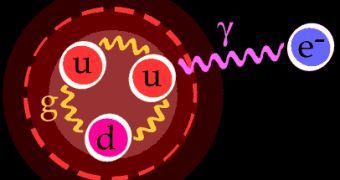The proton is made of three permanent quarks, two 'up' quarks and one 'down' quark, which are hold together by gluons. However, other quarks are constantly appearing and disappearing in and out of existence and in doing so they are influencing the proton's properties.
Last year, the G-Zero collaboration, an international team of over 100 physicists from 19 institutions, probed the proton's interior by bouncing fast-moving electrons off protons in a liquid hydrogen target. Hydrogen is made out of one proton and one electron and it is held together by photons (due to the electromagnetic attraction). In the picture, the up quarks are labeled 'u', the down quark 'd', the gluons 'g', the electron 'e-' and the photon 'gamma'.
The proton's magnetism is determined by its internal structure, i.e. by the relationships between its quarks, and manifests itself by influencing the electron. Thus, by studying how the electron of the hydrogen molecule is scattered, scientists can find out things about the proton's inner structure.
In particular, researchers wanted to know whether other temporary quarks and anti-quarks, that, according to quantum theory, can appear inside the proton for fractions of a second, have any influence whatsoever on proton's magnetism. Out of the six known quarks, they had estimated that it was relatively likely that the so called "strange" quark would appear together with its anti-quark.
In order to detect the appearance of these flimsy quarks they had to get rid of the electromagnetic interaction between the electron and the proton which is so powerful that it eclipses other, more feeble events. Besides having an electric charge, quarks also participate in the so-called weak nuclear interaction, and therefore produce an internal pattern of weak charges. Scientists wanted to detect this weak interaction.
To separate out the effect of the weak interaction within the proton, the team did the following: They sent fast electrons to the liquid hydrogen target; first they sent electrons having a certain spin (rotating around their axis in one direction) and secondly they sent electrons having the opposite spin (rotating around their axis in the opposite direction). The electromagnetic interaction is identical in both cases, but the weak interaction differs. Thus, they managed to measure the weak interaction; the G-Zero experiment provides a map of the proton according to the weak interaction, and permits the strange quarks to be distinguished from the other, permanent, two.
The results were more than they bargained for. They did find that strange quarks and anti-quarks appear and influence the proton's magnetism, but it appears that up to 5% of the proton's magnetic moment comes from strange quarks. This is ten times higher than what theoretical predictions have indicated!
To complete the picture, the G-Zero team has moved the detector to the other side of their target, to detect electrons that bounce backwards off the target protons. Results from that experiment, scheduled to run through much of 2006, will enable the researchers to separately estimate two quantities that they cannot currently untangle: the strange quark contributions to the proton's magnetic moment and to the distribution of charge within it.
The G-Zero results "give the first really good picture" of what strange quarks are doing inside the proton, says John W. Negele of the Massachusetts Institute of Technology, and offer a stiff challenge to theorists. But he adds that a new generation of computers, with architecture dedicated to calculating quark interactions, is enabling theorists to tackle problems that until now they had only dreamed about.

 14 DAY TRIAL //
14 DAY TRIAL //